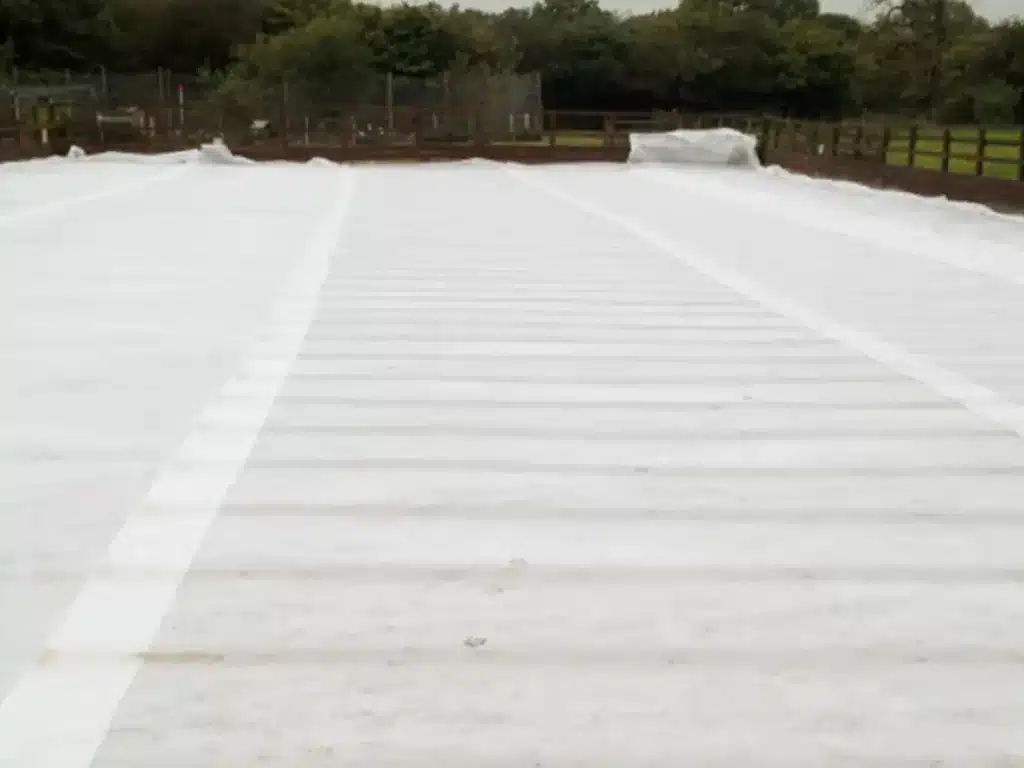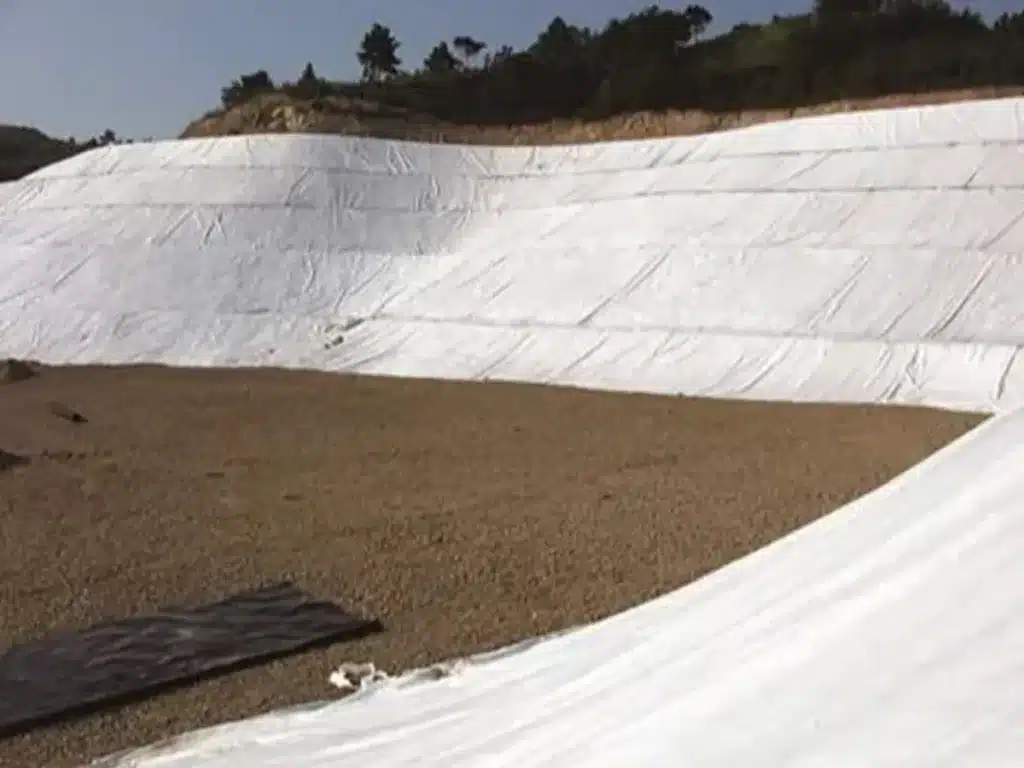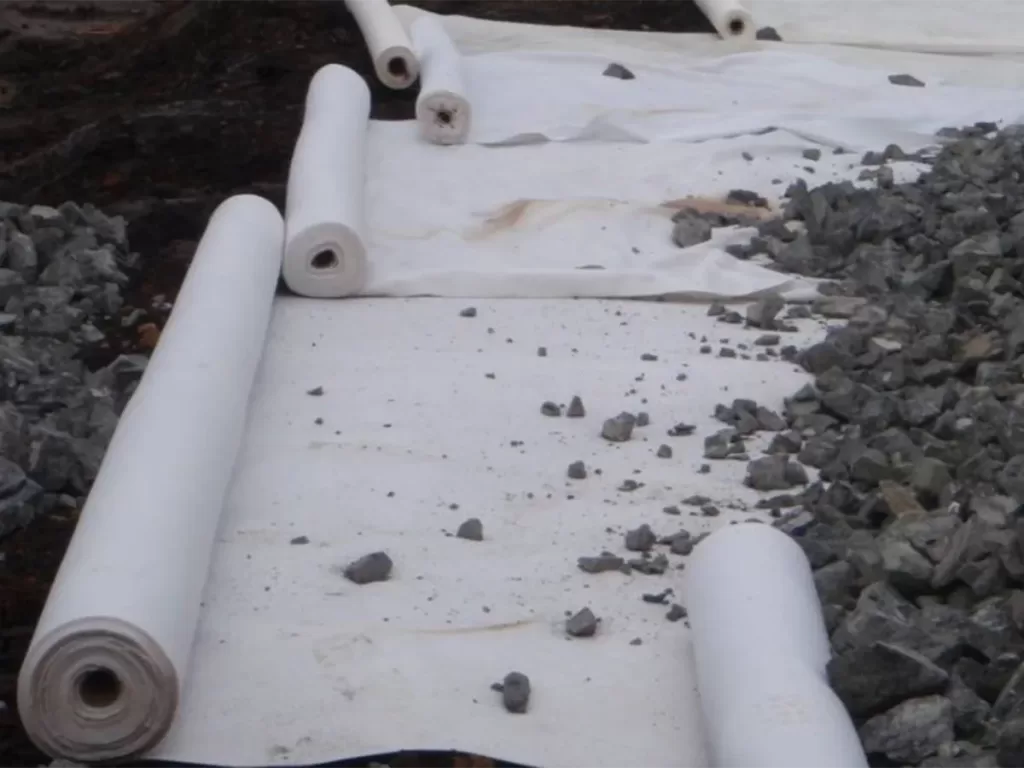+86-159 9860 6917
info@geofantex.com
geofantex@gmail.com
+86-400-8266163-44899
Separation:
- Purpose: Geotextile fabric acts as a barrier that prevents the intermixing of subsoil and aggregate base layers.
- Benefit: This maintains the integrity and stability of the paving system by ensuring that each layer performs its specific function without contamination.
Filtration:
- Purpose: The fabric allows water to pass through while preventing soil particles from moving into the drainage layer.
- Benefit: This helps in maintaining the permeability of the paving system, ensuring efficient water management and reducing the risk of clogging.
Drainage:
- Purpose: Geotextile fabric aids in the quick and effective drainage of water through the paving system.
- Benefit: Enhanced drainage capabilities prevent waterlogging, which can undermine the pavement’s structure and longevity.
Reinforcement:
- Purpose: The fabric adds an extra layer of support to the base and sub-base layers.
- Benefit: This reinforcement increases the load-bearing capacity of the pavement, making it more durable and resistant to heavy traffic loads.
Weed Control:
- Purpose: Geotextile fabric acts as a barrier to weed growth beneath the paving.
- Benefit: This reduces maintenance requirements and prevents weeds from compromising the structural integrity of the paving system.
Longevity:
- Purpose: By preventing the intermixing of materials and maintaining drainage efficiency, the fabric extends the lifespan of the paving system.
- Benefit: It reduces the need for frequent repairs and replacements, making it a cost-effective solution in the long run.
What is Geotextile Fabric?
Definition: Geotextile fabric is a permeable textile material used in civil engineering and environmental projects to enhance soil characteristics. It is typically made from synthetic fibers like polyester or polypropylene.
Composition:
- Synthetic Fibers: Primarily composed of polyester or polypropylene.
- Woven or Non-Woven: Geotextiles can be woven (created by weaving threads together) or non-woven (made by bonding fibers together through chemical, thermal, or mechanical means).
Uses:
- Soil Stabilization: Used in road construction and embankments to stabilize soil.
- Erosion Control: Helps prevent soil erosion in areas like slopes, riverbanks, and shorelines.
- Drainage: Assists in drainage by allowing water to pass through while filtering out soil particles.
- Separation: Prevents different soil layers from mixing, maintaining the integrity of the structures built on top.
- Reinforcement: Adds strength to weak soils, enabling the construction of more stable structures.
Benefits:
- Durability: Resistant to various environmental conditions and chemicals, ensuring a long lifespan.
- Flexibility: Can be used in a variety of applications due to its adaptable nature.
- Cost-Effective: Reduces the need for additional materials and maintenance, leading to cost savings.
- Environmentally Friendly: Helps in sustainable construction practices by reducing soil erosion and improving water quality.
Types of Geotextile Fabric:
- Woven Geotextiles: Strong and durable, ideal for reinforcement and stabilization.
- Non-Woven Geotextiles: More flexible and permeable, suitable for filtration, drainage, and erosion control.
- Knitted Geotextiles: Made by interlocking loops of yarn, used in specialized applications.
How is Geotextile Fabric installed?
Geotextile fabric is installed in between different layers of materials in earthwork projects. The bottom layer, or subgrade, is first prepared according to the project requirements. Then, the geotextile fabric is rolled out and then the top layer is then spread over it.
How does Geotextile Fabric provide separation and reinforcement?
Separation is the most important role geotextile fabrics provide. By being installed in between different layers of materials, it prevents the two materials from mixing and preserves the characteristics of each material.
Geotextile fabric is installed under literally every single new road that is constructed in Australia! When water gets under a road surface, it softens the soil and makes the crushed rock road base mix with the soil beneath. This mixing causes the road base to sag and can cause road pavement surface failures such as potholes.
By installing the geofabric, the fabric prevents the two materials from mixing, and the tensile strength of the fabric helps the pavement subbase “bridge” over any soft spots. Engineers would describe the inclusion of fabrics into pavement subgrades as being just as essential as including reinforcing steel in concrete.
Geotextile Fabric for Permeable Paving
So what does this have to do with permeable paving? Everything! When we install our permeable paving, laying geotextile out is the first thing we do after excavating the site to a suitable subgrade. On top of the geotextile fabric, we then lay any screening sub-base required, and then our permeable concrete and resin-bound pavement is then installed.
Screenings installed on geofabric as a subbase for a permeable driveway
Why is Geofabric important for Permeable Paving?
The geofabric provides separation, meaning that when the permeable paving drains water through to the subgrade, it helps with the following:
On all soils, it prevents the rock from being able to settle down into the subgrade beneath, preventing a possible cause of pavement settlement or cracking
On silty clay soils with slow drainage rates, any build-up of water can lift up fine silty mud out of the clay, but the geotextile fabric prevents the silt from rising up through
On hard clay soils with soft pockets or over soft trenches, the tensile strength of the fabric prevents the rock from settling into the soft soil and helps the subgrade bridge soft or unstable areas
On soft soils or sand, it helps prevent the subsoil from being able to move with water infiltration
As we discussed before, civil contractors put geotextiles under roads to prevent failure due to water ingress. And with permeable paving, the pavement is designed to achieve water ingress!
Geotextile fabric at work, keeping areas of soft silty mud contained prior to a permeable concrete pour
How does Geotextile Fabric achieve drainage and filtration?
Nonwoven geotextile fabrics are designed to be highly permeable to water but a barrier to fine particles. Subsurface drainage systems utilize geotextile fabrics in their design as a filter layer between soil and the drainage material (eg. fine rock in a trench) to keep the fine soil particles out of the drainage system, whilst still allowing water in.
When it comes to subsurface drainage, the secret ingredient is geofabric!!
Nonwoven geotextile fabrics are also highly absorbent like a sponge, so they can assist with drainage by drawing water along them and disrupting the capillary action of water in the subgrade. In road construction, the capillary action of the fabric is used to draw water out of the subgrade and into drainage systems to prevent water damage.
The drainage properties of geotextile fabric can help prevent subgrade degradation under permeable paving on steep inclines
How does Geofabric help with Permeable Paving?
Firstly, the absorption properties can help on steep sites where (in heavy rain events) water will be moving downhill under the permeable pavement, as the geofabric will help wick excess water out of the subgrade, helping to minimize disturbance to the subgrade due to the movement of water. The fabric also helps stabilize the fine surface subgrade material in contact with the geofab. As with any pavement, preventing degradation of the subgrade structure is the key to long-term pavement stability.
On reactive clay soils, it is often necessary to install subsurface drainage to minimize the build-up of excess water. In a “traditional” subsurface drain, the drainage trench is lined with geofabric before being backfilled with free-draining material. But with permeable pavement on clay soil, the entire pavement area is a free-draining material! So in order to maximise the performance of the subsurface drainage the entire subgrade under the permeable pavement should be lined with geotextile fabric. That way, clay silt cannot be carried into the drainage with the passage of water.
Is Geofabric the secret to successful Permeable Paving?
The correct use of geotextile fabric under permeable paving is just one of the many little nuances that need to be done right in setting up for a structurally sound permeable pavement.
If you want permeable paving done without structurally fundamental flaws, then we’d recommend you pick up the phone and give us a call at (03) 9543 3013, or send us an email at info@newdawnpaving.com.au.



Get Free Sample
We’ll respond as soon as possible(within 12 hours)






















